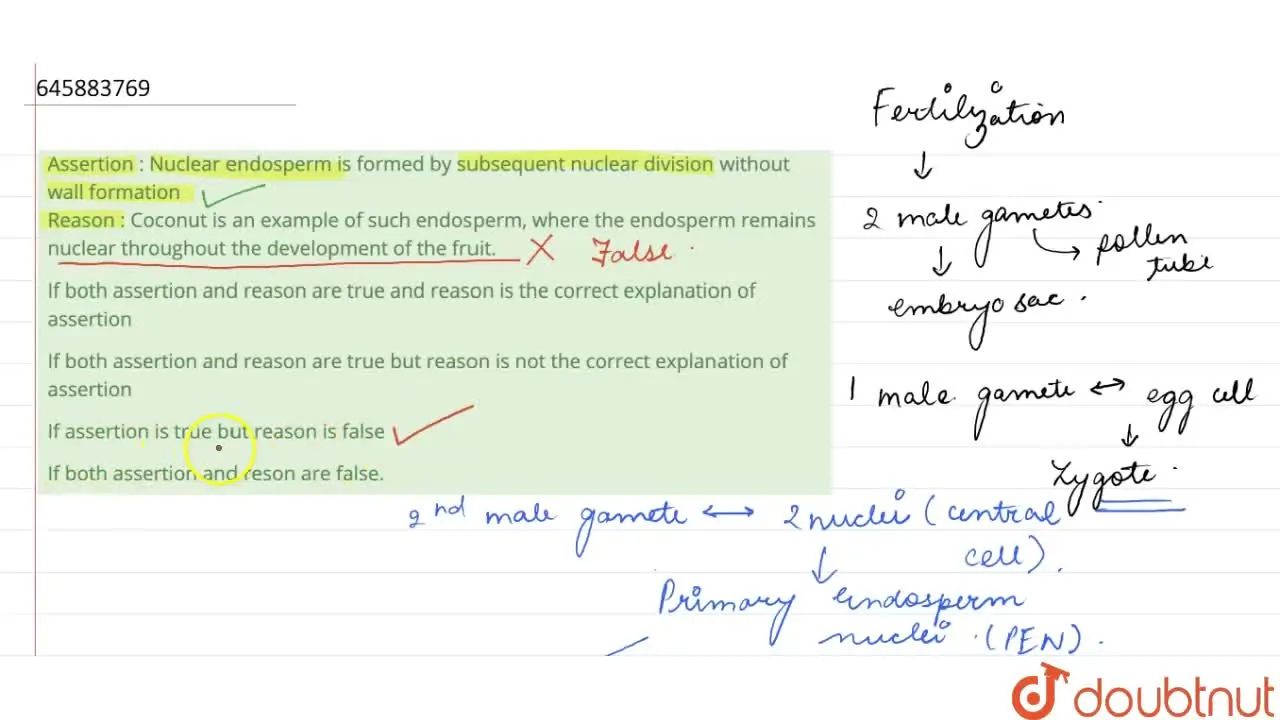Assertion : Nuclear endosperm is formed by subsequent nuclear division without wall formation
Reason : Coconut is an example of such endosperm, where the endosperm remains nuclear throughout the development of the fruit.
If both assertion and reason are true and reason is the correct explanation of assertion
If both assertion and reason are true but reason is not the correct explanation of assertion
If assertion is true but reason is false
If both assertion and reson are false.
The correct Answer is:C
In nuclear endosperm, first and further divisions of primary endosperm nucleus are not followed by cytokinesis or wall formation and thus these free nuclear divisions lead to the formation of a large number of free nuclei in the embryo sac. At maturity, centripetal wall formation may occur to make the tissue partly cellular. The endosperm of coconut is unique in the sense that it is both nuclear and cellular. Here the primary endosperm nucleus undergoes a number of free nuclear divisions. When the fruit is about 50 nm lang the embryo sac remains filled with a watery fluid or milk containing free nuclei and fine cytoplasmic particles. At a later stage when the fruit becomes about100 mm in length the liquid shows in addition to free nuclei, several cells each enclosing variable number of nuclei. Thus coconut has multicellular endosperm (called coconut meat) in the outer part and free nuclear as well as vacuolate endosperm (called coconut milk) in the centre.
Similar Questions
Nuclear endosperm is a character of :
View SolutionIn coconut the endosperm is free-nuclear endosperm
View SolutionWhen nuclear division takes place without cytoplasmic division, it results in the formation of
View SolutionAssertion : In angiosperms, endosperm development precedes embryo development.
Reason : Double fertilisation ensures that the nutritive tissue is formed before the zygotes starts cleaving so that the energy spent on the formation of endosperm does not get wasted.View SolutionA Those plants which produce seeds, without the formation of fruits are called Gymnosperms.
R Endosperm is triploid in AngiospermsView SolutionAssertion : The nucleus of sperm fuses with the nucleus of ovum , before the formation of ootid .
Reason : Diploid nuclear status of organism is essential for its development .View SolutionAt which stage one can distinguish between nuclear and cellular type of endosperm?
View SolutionAssertion :- Endosperm increases the success rate of seedling development.
Reason :- Endosperm arises from PEC.View SolutionRead the following statements and select the correct option.
Assertion : In gymnosperms, endosperm is formed before fertilization and is haploid.
Reason : In angiosperms, endosperm is formed after fertilization and is diploid.View SolutionAssertion :- Morphology of chromosomes is most studied during metaphase of cell division.
Reason :- Complete disintegration of nuclear envelope marks the start of metaphase, second phase of mitosis.View Solution


